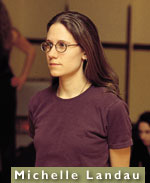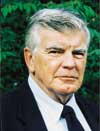
|
|
| Around Tappan Square |
|
Michelle, again: "Having the studio has been rewarding. Some clients come only occasionally, but most are 'regulars', and they like to keep in touch outside the studio, too. It's fun to compare the way they said they felt when they walked in, and how they actually feel when they leave after a class. Each person's load seems to be lightened, and that's what I get from it, too. People really love to come, unlike the gym approach where you have to 'make' yourself work out for your own good. Everyone I know who does it benefits enormously. Sarah's interest in local foods led to her open a produce market as another outlet for local growers, just as her great-great grandfather, her great grandfather, and her grandfather had done in South Jersey, the heart of the Garden State, where Sarah grew up. A natural food store seemed to simply fall into place. Her store attracts townspeople, college faculty and administrators, and people from beyond the town. "Oberlin is an intricate pattern woven of many colorful threads. My goal," she says, "is to contribute to the patterns that already exist here." "There was a time when 'learning and labor' meant something; when students lived and worked intimately with members of the community, and the college and town both recognized their symbiotic relationship. I'm happy to see the beginnings of a return to that." Brad says the big question remains: "If you graduate from Oberlin, how long does it take before you can achieve "townie" status? We have a couple of unique categories to describe a graduate who sticks around: oglios (Oberlin grad living in Oberlin still) or fsl (failure to successfully launch). I am friends with many students, but I have formed many rich friendships in the community, too. People in town are always ready to help you fix things or give you a hand in a bind. I never had that sense living in Denver--that sense of a community so close at hand. "As for the three other Obies who have stayed on, there is a real sense of camaraderie and support. A lot of our work focuses around what's needed to create a healthy community: good food, good health, and a good place. We sell a lot of produce to Kotok's market and the Black River Café. And I've come to really rely on yoga sessions at Solaluna for my weekly recharge. I would have to say, too, that Joe Waltzer fuels the entire environmental revolution in Oberlin. The Black River Café is the preferred destination of all the environmentalists and other co-conspirators concerned with the shifting juggernaut of the global economy to things local and sustainable." Sarah says she felt that she had to prove herself at first, but she succeeded in separating herself from the stereotype of a typical Oberlin student who spends nine months of the year here and not a moment longer. "Inevitably, a mutual respect with the townspeople grew, and I enjoyed being accepted. I'd like to think that most people like having me around--but it was a difficult transition at times." And so Oberlin has acquired four new residents, devoted to the town, its people, and to the college that developed their leadership skills for the benefit of all. History
Professor Geoffrey Blodgett Retires
In 1986, Blodgett was honored with the Western Reserve Architectural Historians award and, in 1993, with the Kerr Prize from the New York State Historical Association. He was a long-time member of the Oberlin Historical Improvement Organization, serving two years on the Oberlin City Planning Commission and six years as chair of the Oberlin City Historic Preservation Commission. Finally, Blodgett was awarded the prestigious Oberlin Alumni Medal during the 2000 commencement exercises in May. (Details to appear in the Fall issue of OAM). He
and his wife, Jane Taggart Blodgett '54, have three children,
Lauren, Barbara, and Sally.
|
 [44074,
cont'd] The quartet has brought to the community
a sharp awareness of environmental concerns. Brad says,
"The focus of my work is the Oberlin Sustainable Agriculture
Project (OSAP), the nonprofit organization that fuses
town and gown. The board includes students, faculty, and
local residents, all sharing the common mission of establishing
of a sustainable local food system. Lorain County is one
of the most threatened counties in the country for farmland
that has been lost lost to sprawling urban development.
We're creating a proactive model of farmland preservation
that unites rural and urban communities with economic
alternatives to support local agriculture."
[44074,
cont'd] The quartet has brought to the community
a sharp awareness of environmental concerns. Brad says,
"The focus of my work is the Oberlin Sustainable Agriculture
Project (OSAP), the nonprofit organization that fuses
town and gown. The board includes students, faculty, and
local residents, all sharing the common mission of establishing
of a sustainable local food system. Lorain County is one
of the most threatened counties in the country for farmland
that has been lost lost to sprawling urban development.
We're creating a proactive model of farmland preservation
that unites rural and urban communities with economic
alternatives to support local agriculture."  "We're
not making a lot of money after paying for equipment and
advertising, and we're trying to develop merchandise to
sell to our clients. But I don't have to pay for yoga
classes anymore, and my full-time job at the college pays
the bills, so I don't stress about that. The ideal situation
will be when I can balance the studio and my computer
job without spending all my spare time trying to grow
the business. But meanwhile, this is really fun. It's
a treat!"
"We're
not making a lot of money after paying for equipment and
advertising, and we're trying to develop merchandise to
sell to our clients. But I don't have to pay for yoga
classes anymore, and my full-time job at the college pays
the bills, so I don't stress about that. The ideal situation
will be when I can balance the studio and my computer
job without spending all my spare time trying to grow
the business. But meanwhile, this is really fun. It's
a treat!"  FOLLOWING
A 40-YEAR CAREER AS A PROFESSOR OF HISTORY AT OBERLIN,
Geoffrey Blodgett '53 retired this year as the Robert
S. Danforth Professor of History. As historian for the
college and town, Blodgett provided through the years
a lasting and irreplaceable service to Oberlin and its
extended community. His intricate knowledge of Oberlin
architectural history led him to write Oberlin Architecture,
College and Town: A Guide to Its Social History,
as well as other publications that reflect his ongoing
expertise in American political and intellectual history.
These include The Gentle Reformers: Massachusetts
Democrats in the Cleveland Era, published by the
Harvard University Press, and essays on the sculptor
Edmonia Lewis, the American novelist Winston Churchill,
landscape designer Frederick Law Olmsted, reformer Henry
George and President Grover Cleveland.
FOLLOWING
A 40-YEAR CAREER AS A PROFESSOR OF HISTORY AT OBERLIN,
Geoffrey Blodgett '53 retired this year as the Robert
S. Danforth Professor of History. As historian for the
college and town, Blodgett provided through the years
a lasting and irreplaceable service to Oberlin and its
extended community. His intricate knowledge of Oberlin
architectural history led him to write Oberlin Architecture,
College and Town: A Guide to Its Social History,
as well as other publications that reflect his ongoing
expertise in American political and intellectual history.
These include The Gentle Reformers: Massachusetts
Democrats in the Cleveland Era, published by the
Harvard University Press, and essays on the sculptor
Edmonia Lewis, the American novelist Winston Churchill,
landscape designer Frederick Law Olmsted, reformer Henry
George and President Grover Cleveland.